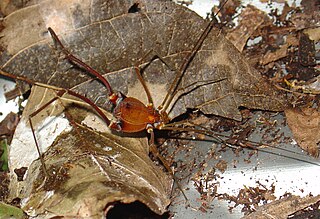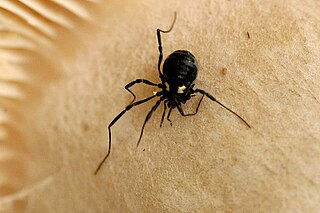
The Opiliones are an order of arachnids colloquially known as harvestmen, harvesters, harvest spiders, or daddy longlegs. As of April 2017, over 6,650 species of harvestmen have been discovered worldwide, although the total number of extant species may exceed 10,000. The order Opiliones includes five suborders: Cyphophthalmi, Eupnoi, Dyspnoi, Laniatores, and Tetrophthalmi, which were named in 2014.

Hogna is a genus of wolf spiders with more than 200 described species. It is found on all continents except Antarctica.

Pachylinae is the most diverse subfamily of the harvestman family Gonyleptidae, including around 400 valid species. Major groups of species occur in the Brazilian Atlantic forest, Bolivian/Peruvian highlands, Argentina and Chilean temperate forest.

Gonyleptoidea is the most diverse superfamily of the Grassatores. It includes around 2,500 species distributed in the Neotropics. They are characterized by the simplified male genitalia, with the glans free subapical in the truncus.

Cosmetidae is a family of harvestmen in the suborder Laniatores. With over 700 species, it is one of the largest families in Opiliones. They are endemic of the New World with a Nearctic-Neotropical distribution where a large fraction of the diversity of Opiliones are represented by this single family. Cosmetidae have the northern extent of their range into the USA, where a small number species occur in the southern states. However, the family is especially diverse in Mexico, Central America and northern South America; especially the Andean realms. Their range also extends further south into Argentina and southern Brazil, but they are absent in Chile. Cosmetidae are prevalent in Amazonian region, but only relatively few also occur in Brazilian Atlantic Forest. Several species are also found in the Caribbean.

The Sclerosomatidae are a family of harvestmen with about 1,300 known species. One former subfamily has been recently removed to form a new family, Globipedidae.

The Nemastomatidae are a family of harvestmen with about 170 described species in 16 recent genera. Several fossil species and genera are known.
The Stygnidae are a family of neotropical harvestmen within the suborder Laniatores.
The Manaosbiidae are a family of neotropical harvestmen within the suborder Laniatores.
Kimulidae is a small neotropical family of the harvestman infraorder Grassatores with about thirty described species.
Caelopygus is a genus of harvestmen found solely in Brazil. It is placed in the sub-family Caelopyginae, and includes two species formerly placed in the genera Liarthrodes Mello-Leitão, 1922 and Heterarthrodes Mello-Leitão, 1935:

Geolycosa is a genus of wolf spiders first described in 1904.
Neopachylus is a genus of harvestmen belonging to the family Gonyleptidae.
Holcobunus is a genus of the order Opiliones in the family Sclerosomatidae. The genus was first described by Roewer, 1910
Bourguyiinae is a Neotropical sub-family of harvestmen in the family Gonyleptidae
Asarcus is a genus of harvestmen in the family Gonyleptidae with four described species. All species are found in Brazil.
Bourguyia is a genus of harvestmen in the family Gonyleptidae with four described species. All species are found in Brazil.






